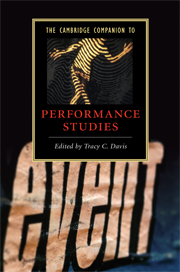Book contents
- Frontmatter
- Introduction: the pirouette, detour, revolution, deflection, deviation, tack, and yaw of the performative turn
- Part I Social polities: history in individuals
- 1 Performance and democracy
- 2 Performance as research: live events and documents
- 3 Movement’s contagion: the kinesthetic impact of performance
- 4 Culture, killings, and criticism in the years of living dangerously: Bali and Baliology
- 5 Universal experience: the city as tourist stage
- 6 Performance and intangible cultural heritage
- Part II Body politics: the individual in history
- Further reading
- Index
3 - Movement’s contagion: the kinesthetic impact of performance
from Part I - Social polities: history in individuals
Published online by Cambridge University Press: 28 January 2009
- Frontmatter
- Introduction: the pirouette, detour, revolution, deflection, deviation, tack, and yaw of the performative turn
- Part I Social polities: history in individuals
- 1 Performance and democracy
- 2 Performance as research: live events and documents
- 3 Movement’s contagion: the kinesthetic impact of performance
- 4 Culture, killings, and criticism in the years of living dangerously: Bali and Baliology
- 5 Universal experience: the city as tourist stage
- 6 Performance and intangible cultural heritage
- Part II Body politics: the individual in history
- Further reading
- Index
Summary
This chapter pursues answers to a question, most urgently posed in relation to dance events, but equally central to all performance: what do you feel, physically, when you watch another body performing? How and why do you respond to the motions of another body? What do you sense? How does your physical experience of what you are seeing help you understand what you are watching? Focusing the inquiry with these questions, I seek to emphasize the sensations of our bones, muscles, ligaments, tendons, and joints. The sensory experience provided by these corporeal elements, often referred to as the kinesthetic sense, has been largely ignored in theories of performance, yet for those of us in dance studies, it remains a predominant aspect of aesthetic experience, one that must be interrogated as part of any inquiry into dance's significance. In the 1930s the dance critic John Martin described movement's effect on viewers as contagious, a term that is defined as the rapid spread of influence or emotion from one body to another, but that also suggests pollution and disease. More recently, the neurophysiologist Vittorio Gallese has described the phenomenon of yawning when someone yawns, or laughing when they laugh, as contagious behavior. What kind of interkinesthetic connectivity forms the basis for such claims? What hold does the kinesthetic have over subjectivity such that its influence would be described as contagious?
- Type
- Chapter
- Information
- The Cambridge Companion to Performance Studies , pp. 46 - 59Publisher: Cambridge University PressPrint publication year: 2008
- 25
- Cited by



